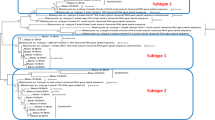Abstract
When in vitro cultivation was used as the ‘gold standard’ for the detection of Blastocystis hominis in stool specimens, simple smear and trichrome staining showed sensitivities of 16.7% and 40.2% and specificities of 94% and 80.4%, respectively. In vitro cultivation also enhanced PCR amplification for the detection of B. hominis in stool specimens. Our data show the usefulness of in vitro cultivation for the detection and molecular study of B. hominis in stool specimens.
Similar content being viewed by others
Avoid common mistakes on your manuscript.
Introduction
Blastocystis hominis is an intestinal protozoan commonly found in humans with a prevalence between 30% and 50% in the developing countries (Hussain Qadri et al. 1989; Nimri 1993; Ashford and Atkinson 1994; Leelayoova et al. 2002; Taamasri et al. 2002). Routine diagnosis is usually performed by a simple smear in normal saline or iodine solution. Several forms of B. hominis can be found in stool specimens, i.e. vacuolar, multivacuolar, avacuolar, granular, ameboid and cyst forms (Stenzel and Boreham 1996). However, most laboratories recognize only the vacuolar form as the diagnostic stage since it can be easily distinguished from other protozoa. As the result, the prevalence determined by wet mount preparation may be underreported. In vitro cultivation methods have been used to enhance detection; however, the usefulness of these methods is still controversial. Our recent report showed that simple smears were less sensitive than short-term in vitro cultivation in Jones medium for the detection of B. hominis in stool specimens (Leelayoova et al. 2002). Permanent staining by trichrome is a standard method for the diagnosis of B. hominis infection in most laboratories. However, the procedure used for trichrome staining might not be suitable for making field assessments. The aim of this study was to compare trichrome staining and in vitro cultivation for the detection of B. hominis in stool specimens. Our knowledge of the epidemiology and pathogenicity of B. hominis infection is still unclear. Genotypic characterization using PCR has been a useful tool for the study of such infection; however, PCR amplification using stool specimens is rather insensitive. One of the methods prior to PCR detection was cultivation. Thus, we also evaluated the usefulness of in vitro cultivation for enhancing DNA detection of B. hominis in stool specimens.
Materials and methods
We evaluated the effectiveness of the three diagnostic methods including simple smear, permanent trichrome staining and short-term in vitro cultivation in terms of their sensitivities and specificities. The research protocol was approved by the Ethics Committee of the Medical Department, the Royal Thai Army. A total of 337 stool specimens from conscripts who lived on an army base in Prachinburi province, Thailand, during February 2003, were used for a comparative study of the three detection methods. Simple smears were made using normal saline and iodine stain, then examined under the 40× objective of a light microscope. Permanently stained smears were prepared using the trichrome modification procedure (Garcia and Bruckner1997) and examined under a 100× objective for 20 oil immersion fields per slide. Short-term in vitro cultivation was performed using Jones medium supplemented with 10% horse serum and incubated at 37°C for 48 h (Jones 1946; Leelayoova et al. 2002). Examination was done by light microscopy under a 40× objective. Using in vitro cultivation as ‘the gold standard’, the sensitivities and specificities of simple smear and trichrome staining were determined using version 6.01 of the Epi Info software package (Centers for Disease Control and Prevention, Atlanta, Ga.). Pair-wise comparisons of the sensitivities and specificities of simple smear and trichrome staining were calculated by χ2-tests, and receiver operating characteristic (ROC) curves were generated using MedCalc (MedCalc software, Mariakerke, Belgium).
A total of 23 B. hominis-positive stool specimens were processed for the DNA extraction by QIAamp DNA Stool Mini Kit (QIAGEN, Germany). These 23 specimens were also cultured in Jones medium for 48 h before DNA was extracted. Successful DNA extraction was demonstrated by nested-PCR amplification for ssu rDNA. Genomic DNA and a primary primer pair (RD5, 5′-GGAAGCTTATC TGGTTGATCCTGCCAGTA-3′; RD3, 5′-GGGATCCTGATCCTTCCGCAGGTT CACCTAC-3′) were used in PCR amplification under the conditions described by Clark (1997). PCR product (1 μl) from the primary amplification and a secondary primer pair (forward, 5′-GGAGGTAGTGACAATAA ATC-3′; reverse, 5′-CGTTCATGATGAACAATT-3′) were used as described by Böhm-Gloning et al. (1997). PCR amplification was performed using a Perkin Elmer 480 Thermal Cycler. A 10-μl PCR product from each reaction mixture was run on a 2% agarose gel (FMC Bioproducts, USA) with 1.5% Tris/borate/EDTA buffer. Gels were stained with ethidium bromide, visualized under UV light and documented on high density printing paper using a UVsave gel documentation system I (Uvitech, UK).
Results and discussion
As shown in Table 1, the prevalence of B. hominis using in vitro cultivation was 30.3% (95%CI, 23.4–35.2), which was six times higher and twice as high as those detected by simple smears and trichrome staining, respectively. When cultivation was used as the gold standard, simple smears and trichrome staining had sensitivities of 16.7% and 40.2%, respectively. The specificities of simple smears and trichrome staining were 94% and 80.4%, respectively (P=0.001). The positive predictive values of simple smears (54.8%) and of trichrome staining (47.1%) were lower than the corresponding negative predictive values (69.7% and 80.4%, respectively). Compared to the cultivation method, the sensitivity of trichrome staining showed no significant difference (P=0.176), while simple smears were significantly different (P<0.0001). In addition, the area under the ROC curve of simple smears and trichrome staining was 0.55 (95%CI, 0.48–0.62) and 0.60 (95%CI, 0.53–0.67), respectively (Fig. 1). The 95% confidence interval of the area under the ROC curve for trichrome staining was significantly higher than 0.5. Thus this method can possibly predict the positive outcome even though the difference of the area under the curves between trichrome staining and simple smears was not significant (P=0.274). Although there was no significant difference between in vitro cultivation and trichrome staining, we recommend in vitro cultivation using Jones medium to study the prevalence of B. hominis infection because of its high sensitivity, convenience and simplicity for a large number of samples, especially for field studies. In addition, for trichrome staining to be performed and examined correctly, it needs experienced technicians. However, if the actual number and forms of B. hominis in fresh specimens need to be determined, trichrome staining should be done before cultivation.
B. hominis is genetically highly variable, as shown by different molecular techniques, mostly PCR (Böhm-Gloning et al. 1997; Clark 1997; Noël et al. 2003; Thathaisong et al. 2003). The molecular study of B. hominis in stool specimens using these techniques will provide better epidemiological data and might explain its pathogenicity. However, PCR detection of B. hominis in stool specimens is rather insensitive. Thus the development of an efficient method for the isolation and extraction of DNA is required prior to PCR. Here we show the usefulness of in vitro cultivation for the PCR study of B. hominis. Of 23 specimens, 22 (98%) cultured and 12 (52%) direct stool specimens gave the positive band at 1,100 bp for ssu rDNA. These data show the advantages of short-term in vitro cultivation, which eases use and facilitates PCR detection of B. hominis without any partial purification steps. DNA extracted directly from the cultivated specimens can provide a specific and reproducible PCR method for further molecular characterization.
In summary, in vitro cultivation is useful for the detection of B. hominis by light microscopy and also for molecular studies using PCR because of increased numbers of the organism available.
References
Ashford RW, Atkinson EA (1992) Epidemiology of Blastocystis hominis infection in Papua New Guinea: age-prevalence and associations with other parasites. Ann Trop Med Parasitol 86:129–136
Böhm-Gloning B, Knobloch J, Walderich B (1997) Five subgroups of Blastocystis hominis isolates from symptomatic and asymptomatic patients revealed by restriction site analysis of PCR-amplified 16S-like rDNA. Trop Med Int Health 2:771–778
Clark CG (1997) Extensive genetic diversity in Blastocystis hominis. Mol Biochem Parasitol 87:79–83
Garcia SL, Bruckner DA (1997) Macroscopic and microscopic examination of fecal specimens. In: Garcia SL, Bruckner DA (eds) Diagnostic medical parasitology, 3rd edn. American Society for Microbiology, Washington, DC., pp 608–651,
Hussain Qadri SM, Al-Okaili GA, Al-Dayel F (1989) Clinical significance of Blastocystis hominis. J Clin Microbiol 27:2407–2409
Jones WR (1946) The experimental infection of rats with Entamoeba histolytica. Ann Trop Med Parasitol 40:130–140
Leelayoova S, Taamasri P, Rangsin R, Naaglor T, Thathaisong U, Mungthin M (2002) In vitro cultivation: a sensitive method for detecting Blastocystis hominis. Ann Trop Med Parasitol 96:803–807
Nimri LF (1993) Evidence of an epidemic of Blastocystis hominis infections in preschool children in northern Jordan. J Clin Microbiol 31:2706–2708
Noël C, Peyronnet C, Gerbod D, Edgcomb VP, Delgado-Viscogliosi P, Sogin ML, Capron M, Viscogliosi E, Zenner L (2003) Phylogenetic analysis of Blastocystis isolates from different hosts based on the comparison of small-subunit rRNA gene sequences. Mol Biochem Parasitol 126:119–123
Stenzel DJ, Boreham PFL (1996) Blastocystis hominis revisited. Clin Microbiol Rev 9:563–584
Taamasri P, Leelayoova S, Rangsin R, Naaglor T, Ketupanya A, Mungthin M (2002) Prevalence of Blastocystis hominis carriage in Thai army personnel based in Chonburi, Thailand. Mil Med 167:643–646
Thathaisong U, Worapong J, Mungthin M, Tan-Ariya P, Viputtigul K, Sudatis A, Noonai A, Leelayoova S (2003) Blastocystis isolates from a pig and a horse are closely related to Blastocystis hominis. J Clin Microbiol 41:967–975
Acknowledgements
This work was financially supported by the Thailand Tropical Diseases Research Programme (T2) (ID 00-1-HEL-24-011). The experiments comply with the current laws of Thailand.
Author information
Authors and Affiliations
Corresponding author
Rights and permissions
About this article
Cite this article
Termmathurapoj, S., Leelayoova, S., Aimpun, P. et al. The usefulness of short-term in vitro cultivation for the detection and molecular study of Blastocystis hominis in stool specimens. Parasitol Res 93, 445–447 (2004). https://doi.org/10.1007/s00436-004-1157-x
Received:
Accepted:
Published:
Issue Date:
DOI: https://doi.org/10.1007/s00436-004-1157-x





